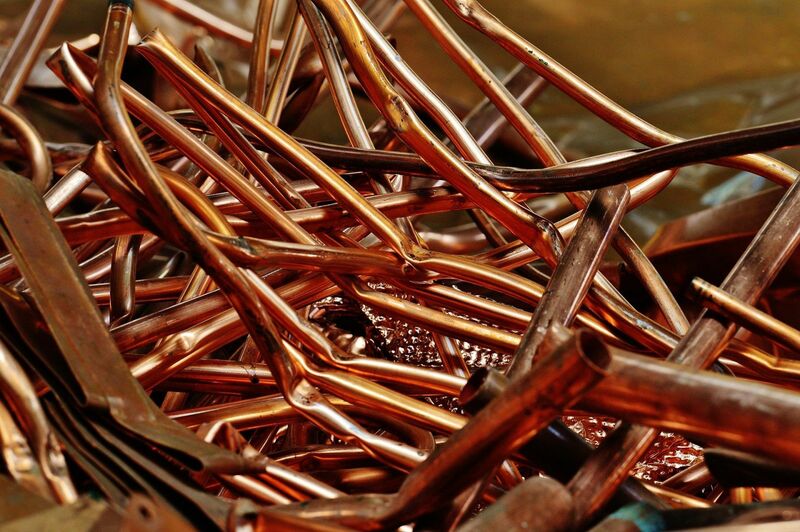
In mid-September, my Barchart article, “Is Now a Good Time to Buy Copper,” concluded:
I favor adding copper to portfolios at the $3.80 per pound level. However, it is virtually impossible to pick bottoms in markets as prices can decline to illogical, irrational, and unreasonable levels that defy even the most bullish supply and demand fundamentals. Therefore, I leave plenty of room to add to my long position on further declines.
Nearby December COMEX copper futures were at the $3.80 per pound level on September 11. On October 13, the red metal was lower under the $3.57 level.
Rates soar, weighing on copper
Rising U.S. interest rates increase the cost of carrying raw material inventories. Simultaneously, higher U.S. rates push the dollar higher against other reserve currencies. While a stronger dollar index since the July low when it briefly probed below the 100 level has been bearish, the trajectory of long-term interest rates has weighed on copper and other commodity prices.

The U.S. 30-year Treasury bond futures chart shows a bearish trend since the 2020 high. Over the past weeks, the long bond futures fell to the lowest level since 2007 at 108-29. At below the 113 level on October 13, the bond futures remain near the recent low. Copper prices have been trending lower in 2023 as rates have been rising.

COMEX copper futures fell from the March 2022 $5.01 high, reaching a $3.15 low four months later in July 2022. In January 2023, nearby copper futures were over the $4.30 level but have made lower highs and lower lows throughout 2023, falling below the $3.60 level in mid-October 2023.
The Chinese economy remains weak
China is the world’s leading refined copper consumer. Copper is a critical input in infrastructure building. In 2023, economic weakness in China has caused Chinese copper demand to decline. Copper may be a barometer for global economic growth or contraction, but Chinese growth is the most significant factor for the path of least resistance of the price of the red metal. China is the world’s second-leading economy, with an over 1.4 billion population. Therefore, copper demand is a function of China’s economy, which has been consistently weak in 2023.
Three bullish factors
The three compelling factors supporting copper at below the $3.60 per pound level are:
- Inventories have been trending lower over the past five years, and production struggles to keep pace with the global demand. It takes nearly a decade to bring new production online, and some of the latest projects in the DRC are in a politically unstable region.
- Inflation and rising interest rates are pushing production costs higher. Financing for new production has become extremely expensive, putting upward pressure on prices.
- The green energy initiatives increase the demand for copper as electric vehicles and wind turbines require increasing amounts of nonferrous metal.
Meanwhile, copper’s long-term bullish trend remains intact despite the decline from over $5 to under $3.60 per pound.

The COMEX copper futures chart dating back to the early 1970s shows a pattern of higher lows and higher highs since the turn of this century.
Three bearish factors
Since bullish and bearish factors continue to pull copper prices in opposite directions, the following three factors have been bearish for the base metal:
- Higher U.S. interest rates increase the cost of carrying inventories, pushing copper lower.
- A rising dollar index is bearish as the dollar is the world’s reserve currency. Even though London is the hub of international copper and base metals trading, the London Metals Exchange prices copper and other nonferrous metals forwards in U.S. dollars.
- The short-term trend has been bearish in 2023, and copper reached a new low in early October and remains near the bottom on October 13.

The chart shows the 2023 bearish trend. December COMEX copper futures reached a $3.5490 double bottom on October 4 and 5 and were only slightly higher on Friday, October 13.
CPER tracks copper futures prices
I remain bullish on copper despite the bearish 2023 trend and the path of least resistance of interest rates and the U.S. dollar. Fundamental supply and demand data continue to support a bottom over the coming weeks and months and a return to the bullish price action over the past decades. However, picking bottoms is virtually impossible in any market as prices can decline to illogical, irrational, and unreasonable levels before reaching a final low. Therefore, any long positions in copper require patience and perseverance, and investors should leave plenty of room to add on further declines.
The most direct route for a copper investment is via the LME forwards or COMEX futures. The U.S. Copper ETF product (CPER) moves higher and lower with copper prices. At $22.14 on October 13, CPER had $129.2 million in assets under management. CPER trades an average of 47,566 shares daily and charges a 0.88% management fee.
Nearby COMEX copper futures prices declined 18.09% in 2023 from the January $4.3330 high to the October $3.5490 low.

As the chart shows, CPER fell 16.8% from $26.38 in January 2023 to $21.95 per share in October 2023.
CPER only trades during U.S. stock market hours, so it can miss highs or lows when the stock market is not operating.
Copper is under pressure because rates have soared, and the dollar index moved higher. However, supply and demand fundamentals suggest that the red metal will find a bottom sooner rather than later.
On the date of publication, Andrew Hecht did not have (either directly or indirectly) positions in any of the securities mentioned in this article. All information and data in this article is solely for informational purposes. For more information please view the Barchart Disclosure Policy here.






